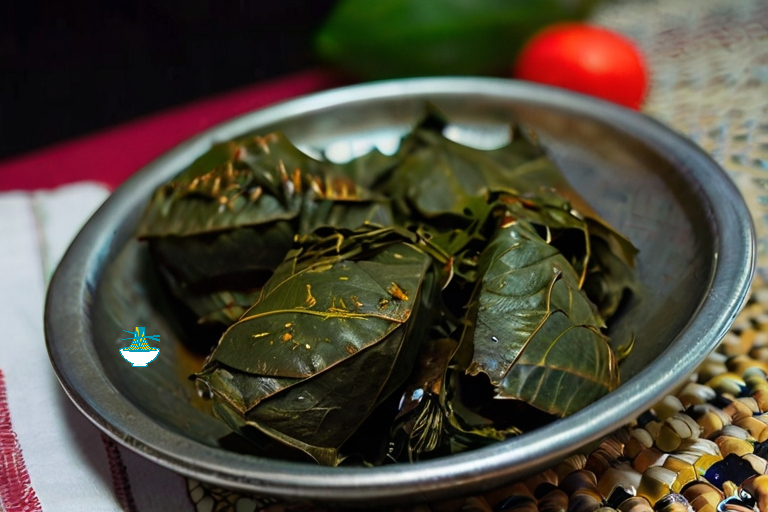Welcome to a culinary journey through the heart of the Central African Republic, where flavorsome traditions meet in a dish that embodies the essence of Central African cuisine – Saka-Saka. Rooted in the rich cultural tapestry of the region, Saka-Saka is more than just a meal; it's a celebration of community, heritage, and the vibrant ingredients that grace the lands of Central Africa.
In this recipe, we'll explore the art of crafting Saka-Saka, a beloved dish cherished by many across the Central African Republic. From its humble beginnings as a simple combination of cassava leaves and spices to its transformation into a hearty, nourishing stew, Saka-Saka encapsulates the warmth and hospitality of Central African cooking.
Join us as we delve into the intricacies of preparing this delectable dish, where each step holds the promise of savory delights and culinary enchantment. Get ready to embark on a culinary adventure as we unlock the secrets of Saka-Saka, bringing a taste of the Central African Republic straight to your kitchen.
Ingredients:
- 500g cassava leaves, finely chopped
- 1 onion, finely chopped
- 2 tomatoes, diced
- 2 cloves garlic, minced
- 1 red bell pepper, diced
- 1 scotch bonnet pepper (optional, for spice)
- 400ml canned palm oil
- Salt, to taste
- Pepper, to taste
- 500g smoked fish or meat (optional, for added flavor)
- 2 cups water
- Cooked rice or fufu, for serving

Instructions:
1- Prepare the cassava leaves by washing them thoroughly and chopping them finely. Set aside.
2- In a large pot, heat the palm oil over medium heat. Add the chopped onion and garlic, and sauté until softened and fragrant, about 3-4 minutes.
3- Add the diced tomatoes, bell pepper, and scotch bonnet pepper (if using) to the pot. Cook until the vegetables are softened, stirring occasionally, for about 5-6 minutes.
4- If using smoked fish or meat, add it to the pot at this stage and cook for an additional 2-3 minutes to allow the flavors to meld.
5- Add the chopped cassava leaves to the pot, stirring well to combine with the other ingredients. Cook for about 5 minutes, allowing the leaves to wilt slightly.
6- Pour in the water, ensuring that it covers the cassava leaves. Season with salt and pepper to taste.
7- Reduce the heat to low, cover the pot, and simmer the Saka-Saka for about 30-40 minutes, stirring occasionally, until the cassava leaves are tender and the flavors have melded together.
8- Once cooked, taste and adjust the seasoning if necessary. If the stew is too thick, you can add more water to achieve your desired consistency.
9- Serve the Saka-Saka hot with cooked rice or fufu, allowing the flavors to shine through with every comforting bite.
Enjoy your authentic Central African Republic Saka-Saka, a dish brimming with the flavors of tradition and heritage!
Nutritional Values:
Here's an approximation of the nutritional values for the ingredients listed in the Saka-Saka recipe:
Cassava Leaves (500g):
- Calories: 200 kcal
- Carbohydrates: 35g
- Protein: 10g
- Fat: 1g
- Fiber: 10g
benefits:Rich in antioxidants, vitamins A and C, and minerals such as iron and calcium, cassava leaves contribute to immune health, vision, and bone strength.
Onion (1 medium-sized):
- Calories: 45 kcal
- Carbohydrates: 11g
- Protein: 1g
- Fat: 0g
- Fiber: 2g
benefits:Onions are packed with antioxidants and nutrients like vitamin C, which supports immune function, and sulfur compounds that may have anti-inflammatory properties and promote heart health.
Tomatoes (2 medium-sized):
- Calories: 50 kcal
- Carbohydrates: 11g
- Protein: 2g
- Fat: 0g
- Fiber: 3g
benefits:Tomatoes are an excellent source of vitamin C, potassium, and lycopene, a powerful antioxidant associated with reducing the risk of chronic diseases and promoting heart health.
Garlic (2 cloves):
- Calories: 10 kcal
- Carbohydrates: 2g
- Protein: 0g
- Fat: 0g
- Fiber: 0g
benefits:Garlic contains compounds with potent medicinal properties, including allicin, which may help boost the immune system, reduce blood pressure, and lower cholesterol levels.
Red Bell Pepper (1 medium-sized):
- Calories: 45 kcal
- Carbohydrates: 9g
- Protein: 1g
- Fat: 0g
- Fiber: 3g
benefits:Red bell peppers are high in vitamin C, antioxidants, and fiber, supporting immune function, eye health, and digestion.
Scotch Bonnet Pepper (1 pepper):
- Calories: 20 kcal
- Carbohydrates: 5g
- Protein: 1g
- Fat: 0g
- Fiber: 2g
benefits:Scotch bonnet peppers contain capsaicin, which may have metabolism-boosting and pain-relieving properties, as well as vitamins A and C, contributing to immune support and overall health.
Palm Oil (400ml):
- Calories: 3400 kcal
- Fat: 400g
benefits:Palm oil is rich in vitamin E, antioxidants, and healthy fats, which can support skin health, improve vitamin absorption, and provide energy.
Smoked Fish or Meat (500g): (Nutritional values can vary significantly depending on the type of fish or meat used. Here's a rough estimate for smoked fish.)
- Calories: 800 kcal
- Protein: 100g
- Fat: 40g
benefits:Smoked fish or meat can be a good source of protein, essential amino acids, vitamins B12 and D, and minerals like iron and zinc, contributing to muscle repair, bone health, and overall nutrition.
Water (2 cups):
- No significant nutritional value.
benefits:Although water itself does not provide nutrients, it is essential for hydration, regulating body temperature, and supporting bodily functions such as digestion and nutrient transport.
Cooked Rice or Fufu (for serving): (Nutritional values depend on the type of rice or fufu and the portion size.)
benefits:Rice and fufu are primarily sources of carbohydrates, providing energy for the body. Depending on the type, they may also contain some fiber and micronutrients.
Keep in mind that these values are approximate and can vary based on factors such as cooking methods and specific ingredients used. Additionally, the nutritional values for some ingredients, like palm oil and smoked fish/meat, are high in fat and calories, so portion control may be necessary for those monitoring their intake.


Comments